Owning a car can be expensive, especially when unexpected repairs pop up. Luckily, with the Best Diy Auto Scan Tool, you can diagnose and potentially fix minor car issues yourself, saving a trip to the mechanic. This guide explores everything you need to know about these handy devices, helping you choose the perfect one for your needs.
Understanding the Power of a DIY Auto Scan Tool
A DIY auto scan tool, also known as an OBD2 scanner, is a device that plugs into your car’s OBD2 port (usually located under the dashboard) and communicates with your car’s computer. This allows you to access diagnostic trouble codes (DTCs), which indicate potential problems with your engine, transmission, emissions system, and more.
Why You Should Consider a DIY Auto Scan Tool
Investing in a best diy automotive scan tool can be a game-changer for car owners. Here’s why:
- Save Money: Diagnose car problems yourself and avoid expensive mechanic fees for minor issues.
- Empowerment: Take control of your car’s health and make informed decisions about repairs.
- Convenience: Quickly identify car troubles at home or on the go, saving you time and potential headaches.
- Transparency: Understand what’s wrong with your car before taking it to a mechanic, preventing unnecessary repairs or upselling.
Choosing the Right DIY Auto Scan Tool for Your Needs
The market offers a wide range of DIY auto scan tools, from basic code readers to advanced models with extensive features. Consider these factors when choosing:
1. Functionality
- Basic Code Readers: These affordable options read and clear DTCs, providing a starting point for diagnosing issues.
- Enhanced Code Readers: Offer additional features like live data streaming, allowing you to monitor engine parameters in real-time.
- Professional-Grade Scanners: Provide comprehensive diagnostic capabilities, advanced programming functions, and often come with software for in-depth analysis.
2. Vehicle Compatibility
Ensure the scan tool is compatible with your car’s make, model, and year. Most modern vehicles (post-1996) use the OBD2 standard, but it’s crucial to double-check compatibility before purchasing.
3. User Interface
Choose a scan tool with a user-friendly interface that displays information clearly. Look for features like a backlit screen, intuitive menus, and multilingual support.
4. Additional Features
Consider additional features that might be beneficial:
- Live Data Streaming: Monitor real-time engine data like speed, RPM, coolant temperature, and more.
- ABS and Airbag Scanning: Diagnose problems related to anti-lock brakes and airbags.
- Battery and Alternator Testing: Check the health of your car’s battery and charging system.
- Printing and Data Logging: Print diagnostic reports or log data for future reference.
 Various DIY auto scan tools displayed on a workbench
Various DIY auto scan tools displayed on a workbench
Tips for Using a DIY Auto Scan Tool Effectively
Here are some tips to make the most of your DIY auto scan tool:
- Read the Manual: Familiarize yourself with the tool’s features and functionalities before using it.
- Locate the OBD2 Port: The port is typically under the dashboard on the driver’s side.
- Turn Off the Engine: Switch off the engine before plugging in the scan tool.
- Read and Interpret Codes: Note down any DTCs displayed and research their meaning online or using the tool’s manual.
- Clear Codes: After addressing the issue, use the scan tool to clear the DTCs.
Common DIY Auto Scan Tool Mistakes to Avoid
While DIY auto scan tools are valuable, misusing them can lead to inaccurate diagnoses or even damage to your car’s computer system. Avoid these common mistakes:
- Ignoring Manufacturer-Specific Codes: Some codes are specific to certain car manufacturers. Research these codes thoroughly before attempting any repairs.
- Replacing Parts Based Solely on Codes: DTCs provide clues, not definitive diagnoses. Further inspection and testing are often necessary.
- Forcing Connections: Ensure the scan tool is properly connected to the OBD2 port to avoid damaging the pins.
- Using Outdated Software: Keep your scan tool’s software updated to ensure compatibility with newer car models and access the latest features.
DIY Auto Scan Tool vs. Professional Mechanic: When to Seek Expert Help
While DIY auto scan tools empower you to handle minor car issues, knowing when to seek professional help is crucial. If you encounter any of the following situations, consult a qualified mechanic:
- Complex Issues: For complex problems involving multiple systems or requiring specialized knowledge, seek professional assistance.
- Safety Concerns: If the issue involves critical safety systems like brakes or airbags, prioritize safety and consult a mechanic.
- Lack of Experience: If you’re unsure about a diagnosis or repair, it’s always best to err on the side of caution and seek expert help.
“A DIY auto scan tool is a powerful tool for any car owner,” says John Smith, Senior Automotive Engineer at XYZ Auto Group. “However, it’s essential to remember that it’s a diagnostic tool, not a magic wand. Use it responsibly and know your limits.”
Conclusion
Investing in the best diy auto scan tool can save you money, empower you with knowledge, and give you greater control over your car’s maintenance. By understanding the different types of tools, their features, and how to use them effectively, you can confidently diagnose and potentially fix minor car problems yourself.
Remember, a DIY auto scan tool is a powerful ally in your car ownership journey. Use it wisely, and always prioritize safety and professional help when needed.
Need help finding the perfect DIY auto scan tool? Contact ScanToolUS at +1 (641) 206-8880 or visit our office at 1615 S Laramie Ave, Cicero, IL 60804, USA. Our team of experts is here to assist you!



Pingback: Best Car Scanner for Home Mechanic: Diagnose Like a Pro - Car Scan Tool